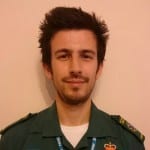 Viet-Hai Phung presented his work on the perceptions and experiences of Community First Responders (CFRs) in Lincolnshire at the recent Mediterranean Emergency Medicine Congress (MEMC). The Congress, organised by the American Academy of Emergency Medicine (AAEM), took place in the very smart surroundings of the Corinthia Hotel in Lisbon, Portugal from 8-10 September 2017. Despite the title of the Congress, this was a truly international conference, with delegates from North America, the Middle East, Africa and Australasia presenting.
Viet-Hai Phung presented his work on the perceptions and experiences of Community First Responders (CFRs) in Lincolnshire at the recent Mediterranean Emergency Medicine Congress (MEMC). The Congress, organised by the American Academy of Emergency Medicine (AAEM), took place in the very smart surroundings of the Corinthia Hotel in Lisbon, Portugal from 8-10 September 2017. Despite the title of the Congress, this was a truly international conference, with delegates from North America, the Middle East, Africa and Australasia presenting.
Professor Lee Alan Wallis, Head of Emergency Medicine for the Western Cape Government, was the keynote speaker at the opening ceremony. He talked about the particular challenges of  emergency medicine provision in southern Africa, where in some countries the infrastructure is extremely basic. Other plenary speakers included: Professor James Ducharme from McMaster University in Toronto, who talked about the complex relationship between pain relief, patient satisfaction and addiction and Dr Eveline Hitti from the American University in Beirut, who spoke about the glass ceiling for women working in emergency medicine.
emergency medicine provision in southern Africa, where in some countries the infrastructure is extremely basic. Other plenary speakers included: Professor James Ducharme from McMaster University in Toronto, who talked about the complex relationship between pain relief, patient satisfaction and addiction and Dr Eveline Hitti from the American University in Beirut, who spoke about the glass ceiling for women working in emergency medicine.
Viet-Hai presented the interview study that has been undertaken with colleagues Prof Niro Siriwardena, Ian Trueman and Prof Roderick Ørner on the first morning of the conference. The presentation was well-received with only minor points of clarification from the audience concerning the extent of their use in the UK and the levels of training they undertake.
What was interesting about the conference was the sharing of best practice from around the world on many salient problems in emergency medicine, such as alleviating patient overcrowding in the emergency department. All this within the setting of the wonderful city of seven hills, Lisbon.
By Viet-Hai Phung














